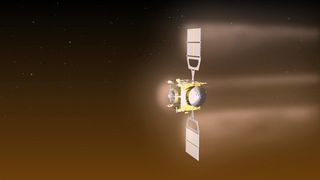Europe's Mars Mission Is About to 'Surf' the Red Planet's Atmosphere
The ExoMars Trace Gas Orbiter (TGO) is about to go surfing — at the Red Planet.
Through 13 months of delicate maneuvers, the spacecraft will carefully skim above Mars' atmosphere to refine its orbit. Once that's finished in 2018, TGO will be all set to do science at Mars — and also ready to communicate with robots on the surface, such as the upcoming ExoMars rover.
The mission of TGO is to better understand the quantities of rare gases in the Martian atmosphere. It's well known that carbon dioxide is the main component (making up 95 percent of the atmosphere), but there are lesser yet still important gases that together make up less than 1 percent of the atmosphere's volume. These gases include methane, water vapor, nitrogen dioxide and acetylene, according to the European Space Agency, which runs the ExoMars program.
"Of high interest is methane, which on Earth is produced primarily by biological activity, and to a smaller extent by geological processes such as some hydrothermal reactions," the agency wrote in a statement. "The spacecraft will also seek out water or ice just below the surface, and will provide colour and stereo context images of surface features, including those that may be related to possible trace gas sources."
What Is Aerobraking?

Because every pound carried to space is expensive, aerobraking provides a way to control a spacecraft's orbit without using a lot of fuel. Once a spacecraft is in orbit around a planet with enough atmosphere, the spacecraft can slow itself down and lower its orbital altitude by passing through thin atmospheric gases, creating drag. The solar panels on the spacecraft are used to steer the spacecraft and keep it steady during this maneuver, which must be watched closely.
RELATED: Europe to Fund ExoMars Rover Despite Lander Crash
"Instead of using onboard jets and propellant to adjust a spacecraft's orbit, aerobraking uses the atmosphere as both a brake and a steering wheel," NASA wrote on a Mars Odyssey web page. "The technique, however, shares more elements with sailing than with driving: successful aerobraking depends upon precise navigation, knowledge of weather and a solid understanding of the forces the craft can withstand."
Get the Space.com Newsletter
Breaking space news, the latest updates on rocket launches, skywatching events and more!
What Past Missions Did Aerobraking?

Several past missions have already carried out aerobraking maneuvers, mostly at Mars. The first maneuver, though, took place at Earth. Japan's Hiten, or MUSES-A, spacecraft deliberately moved through a part of Earth's atmosphere twice to lower its velocity and apogee (highest point above the Earth) in 1991. Hiten's mission was to study the moon from a highly elliptical Earth orbit.
Other examples of aerobraking include NASA's Magellan spacecraft (which did aerobraking at Venus in 1993 to circularize its orbit), NASA's Mars Global Surveyor in 1997 (which used its solar panels to control its path through the upper atmosphere), and the Mars Odyssey and Mars Reconnaissance Orbiter spacecraft. Venus Express also tested out aerobraking techniques at Venus in 2014 to help future mission development for the European Space Agency.
What Maneuvers Will ExoMars Do?

So far, the TGO spacecraft has performed four burns in 2017. On Jan. 19, 23 and 27, the main engine of the spacecraft raised its orbit from a near-equatorial trajectory to one that is almost north-south. This was followed up by a minor "trim" burn on Feb. 5 to refine the orbit, which is common after large orbital changes such as this one.
RELATED: Mars Methane Scout Takes Test Run to Sniff Out Life
All of this work sets up TGO for the next phase: several months of aerobraking that is expected to bring the spacecraft to a near-circular final science orbit, with an altitude of about 250 miles (400 kilometers). The spacecraft will gently skim the top of the atmosphere between March 2017 and April 2018, slowly adjusting its orbit.
How Will This Help the ExoMars Mission?

The first mission of ExoMars was to deliver the lander Schiaparelli to an area with good communications that is also near the equator — the reason why the Trace Gas Orbiter was put at an equatorial orbit before moving into one much closer to the pole. Because a polar orbit allows the spacecraft to see more of the surface, this will allow it to image a wider range of features at Mars.
ESA chose to keep the spacecraft away from a strict polar orbit, inclined at 74 degrees, so that TGO can keep communicating with landers on the surface. This will be especially important after the ExoMars rover launches for the Red Planet in 2020. Among its instruments will be the first large drill on Mars, allowing for an unprecedented look below the surface.
What's Next?

As controllers work on the aerobraking maneuvers, scientists will be busy as well in the coming weeks. That's because the instruments on ExoMars will be briefly switched on to make calibration measurements from the new orbit. "This will add to the test data collected during two dedicated orbits late last year, and is important preparation for the main science mission," ESA said.
The last test saw the Atmospheric Chemistry Suite turned on to look at carbon dioxide in the atmosphere (the main component of Martian "air" by far) and the Nadir and Occulatation for Mars Discovery instrument looking for evidence of water in the atmosphere. Additionally, images were taken by the Color and Stereo Surface Imaging System and neutron flow was captured by the Fine Resolution Epithermal Neutron Detector.
WATCH VIDEO: Will ExoMars Find Life On The Red Planet?
Originally published on Seeker.
Join our Space Forums to keep talking space on the latest missions, night sky and more! And if you have a news tip, correction or comment, let us know at: community@space.com.

Elizabeth Howell (she/her), Ph.D., was a staff writer in the spaceflight channel between 2022 and 2024 specializing in Canadian space news. She was contributing writer for Space.com for 10 years from 2012 to 2024. Elizabeth's reporting includes multiple exclusives with the White House, leading world coverage about a lost-and-found space tomato on the International Space Station, witnessing five human spaceflight launches on two continents, flying parabolic, working inside a spacesuit, and participating in a simulated Mars mission. Her latest book, "Why Am I Taller?" (ECW Press, 2022) is co-written with astronaut Dave Williams.











